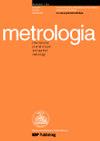CCQM-K160: Platinum Group Elements in Automotive Catalyst
IF 2.4
3区 工程技术
Q2 INSTRUMENTS & INSTRUMENTATION
引用次数: 0
Abstract
The platinum group elements (PGEs) play an important role in reducing emissions from automotive vehicles through their use in catalytic convertors but also for catalysis in the pharmaceutical industry. The immense economic value of platinum (Pt), palladium (Pd) and rhodium (Rh) highlights the importance of highly accurate measurements. Therefore, there is a need for National Metrology Institutes (NMIs) and Designated Institutes (DIs) to demonstrate measurement capability in this space. A pilot comparison (CCQM-P63) for precious metals in automotive catalyst took place in 2006, but with a limited number of institutes participating. Furthermore, this study was performed over 17 years ago. Therefore, there was a need to maintain existing capability and demonstrate new capability in a key comparison, in order to claim calibration and measurement capability claims (CMCs). With the core capability matrix, this study falls into the "Difficult to dissolve metals/metal oxides" which will support CMC categories 8 (Metal and metal alloys), 9 (Advanced materials) and 14 (Other materials). Eleven NMIs and DIs participated in the Key Comparison CCQM-K160 Platinum Group Elements in Automotive Catalyst. Participants were requested to evaluate the mass fractions of Pt, Pd and Rh in mg/kg in an unused autocatalyst material (cordierite ceramic base). The Key Comparison Reference Values (KCRVs) and Degrees of Equivalence (DoEs) were calculated utilising the NIST Decision Tree for the measurands. The participants utilised a number of sample preparation and analytical methods including hot plate digestion, microwave digestion and sodium fusion, followed by either atomic absorption spectroscopy (AAS), inductively coupled plasma optical emission spectroscopy (ICP-OES) or inductively coupled plasma mass spectrometry (ICP-MS) detection. Several calibration techniques were used, namely external calibration, standard addition, isotope dilution mass spectrometry (IDMS) and an exact matching procedure. Additionally, one participant employed instrumental neutron activation analysis (INAA) with k0 standardisation which is a direct solid analysis method. The majority of participants claimed traceability to NIST primary calibrants or their own CRMs. Furthermore, several matrix CRMs were included or spiked samples for quality control. All institutes were required to determine the dry mass fraction using the stipulated protocol. The NIST decision tree was implemented for the calculation of the KCRVs and DoEs. The participant results overall showed good agreement with the KCRV, despite the variety of dissolution procedures and measurement techniques for this highly complex matrix and challenging measurands. Successful participation in CCQM-K160 demonstrated measurement capabilities for the determination of mass fraction of Pt, Pd and Rh in the mg/kg range and will support broad scope CMC claims for a wide range of challenging matrices. To reach the main text of this paper, click on Final Report. Note that this text is that which appears in Appendix B of the BIPM key comparison database https://www.bipm.org/kcdb/. The final report has been peer-reviewed and approved for publication by the CCQM, according to the provisions of the CIPM Mutual Recognition Arrangement (CIPM MRA).CCQM-K160:汽车催化剂中的铂族元素
铂族元素(PGEs)通过在催化转换器中的使用,在减少汽车尾气排放方面发挥着重要作用,同时也用于制药业的催化反应。铂 (Pt)、钯 (Pd) 和铑 (Rh) 的巨大经济价值凸显了高精度测量的重要性。因此,国家计量院(NMI)和指定机构(DI)有必要展示这一领域的测量能力。2006 年进行了汽车催化剂中贵金属的试点比对(CCQM-P63),但参与的机构数量有限。此外,这项研究是 17 年前进行的。因此,有必要在关键比对中保持现有能力并展示新能力,以申请校准和测量能力声明(CMC)。根据核心能力矩阵,这项研究属于 "难溶解金属/金属氧化物",将支持 CMC 类别 8(金属和金属合金)、9(先进材料)和 14(其他材料)。11 个国家监测机构和指定机构参加了关键对比 CCQM-K160 汽车催化剂中的铂族元素。要求参与者评估未使用过的汽车催化剂材料(堇青石陶瓷基底)中铂、钯和铑的质量分数(以毫克/千克为单位)。关键比较参考值 (KCRV) 和等效度 (DoE) 是利用 NIST 的决策树计算出来的。参与者采用了多种样品制备和分析方法,包括热板消解、微波消解和钠融合,然后进行原子吸收光谱(AAS)、电感耦合等离子体光发射光谱(ICP-OES)或电感耦合等离子体质谱(ICP-MS)检测。使用了几种校准技术,即外部校准、标准添加、同位素稀释质谱法 (IDMS) 和精确匹配程序。此外,一位与会者采用了 k0 标准化的仪器中子活化分析(INAA),这是一种直接的固体分析方法。大多数与会者声称可追溯到 NIST 初级校准器或他们自己的有证标准物质。此外,还包括一些基质有证标准物质或用于质量控制的加标样品。所有机构都必须使用规定的规程测定干质量分数。在计算 KCRV 和 DoE 时采用了 NIST 决策树。尽管针对这种高度复杂的基质和具有挑战性的测量物采用了多种溶解程序和测量技术,但参与者的结果总体上与 KCRV 非常吻合。成功参与 CCQM-K160 证明了测定毫克/千克范围内的铂、钯和铑质量分数的测量能力,并将支持各种具有挑战性基质的广泛 CMC 声明。要阅读本文正文,请点击最终报告。请注意,该文本是 BIPM 关键对比数据库 https://www.bipm.org/kcdb/ 附录 B 中的文本。根据 CIPM 互认安排 (CIPM MRA) 的规定,最终报告已通过同行评审,并批准由 CCQM 出版。
本文章由计算机程序翻译,如有差异,请以英文原文为准。
求助全文
约1分钟内获得全文
求助全文
来源期刊

Metrologia
工程技术-物理:应用
CiteScore
2.80
自引率
25.00%
发文量
137
审稿时长
12 months
期刊介绍:
Published 6 times per year, Metrologia covers the fundamentals of measurements, particularly those dealing with the seven base units of the International System of Units (metre, kilogram, second, ampere, kelvin, candela, mole) or proposals to replace them.
The journal also publishes papers that contribute to the solution of difficult measurement problems and improve the accuracy of derived units and constants that are of fundamental importance to physics.
In addition to regular papers, the journal publishes review articles, issues devoted to single topics of timely interest and occasional conference proceedings. Letters to the Editor and Short Communications (generally three pages or less) are also considered.
 求助内容:
求助内容: 应助结果提醒方式:
应助结果提醒方式:


